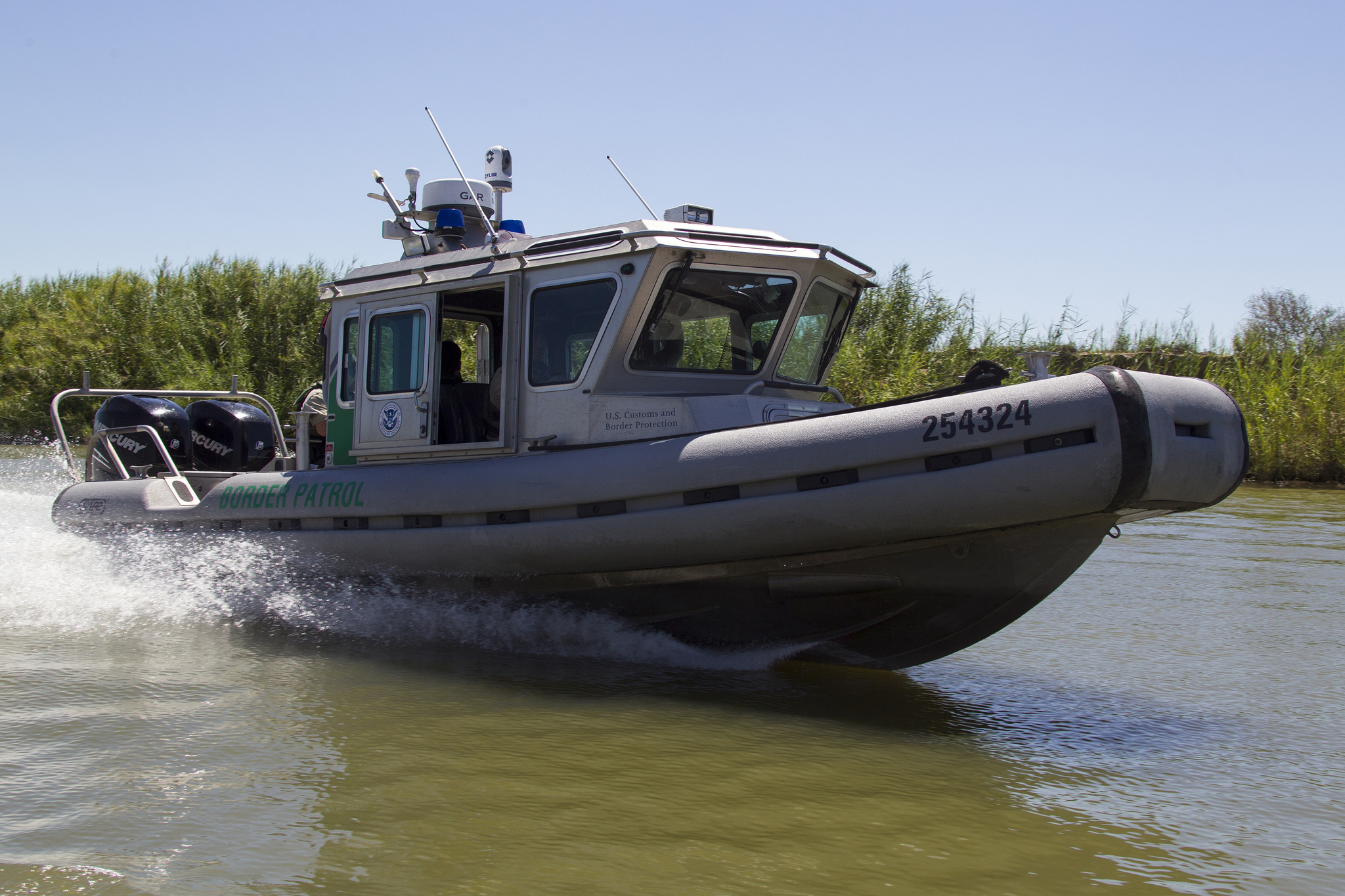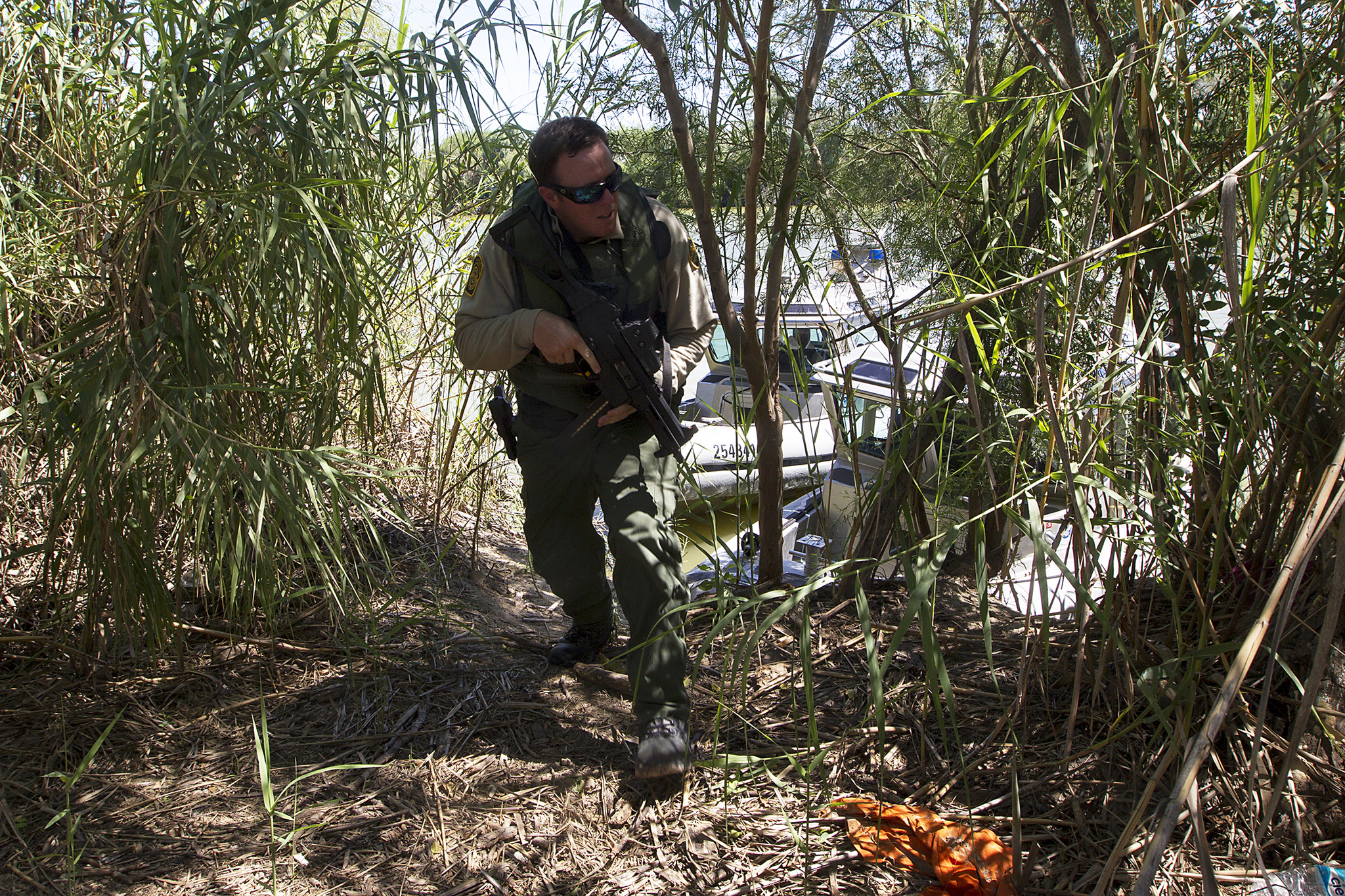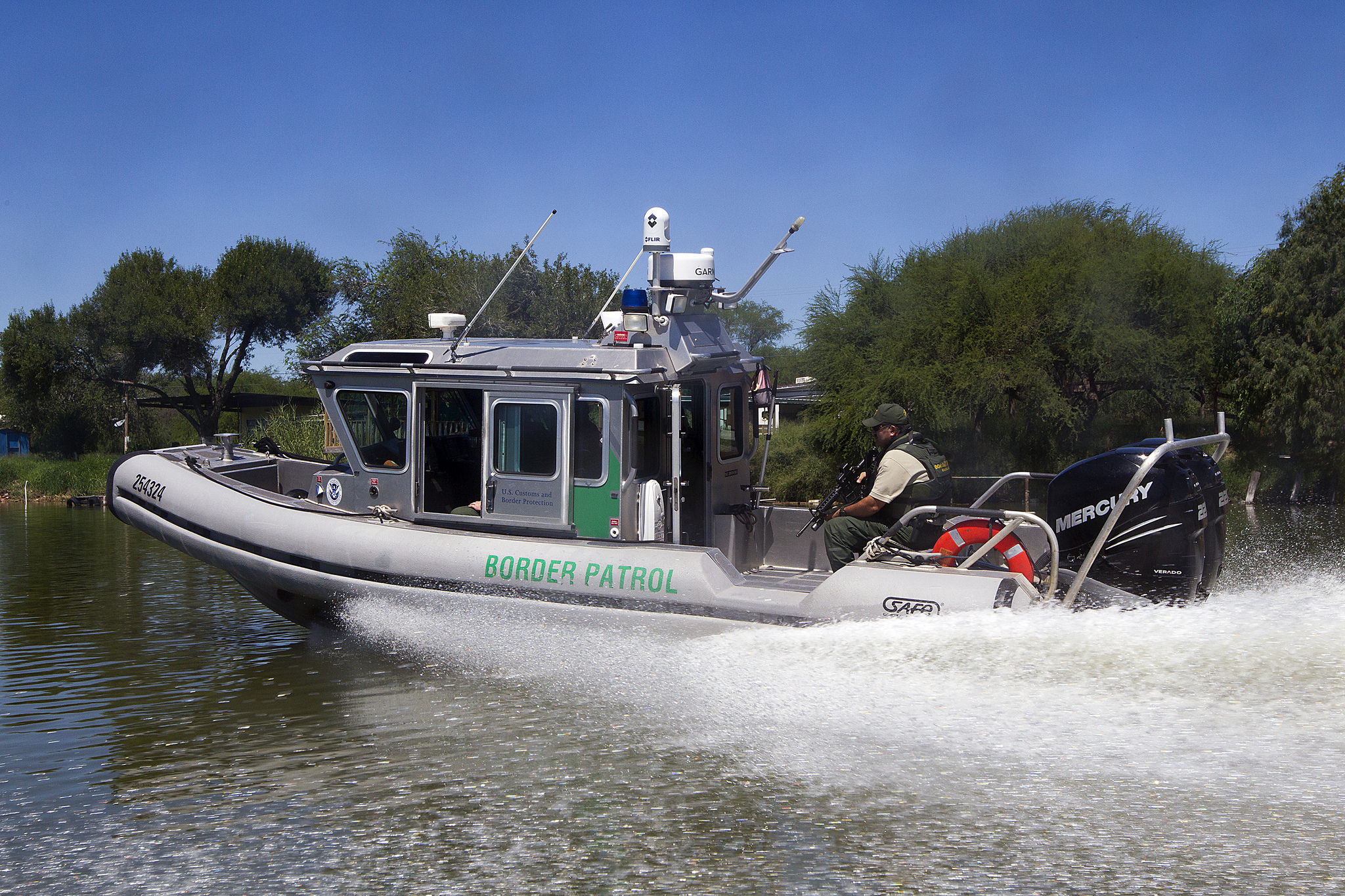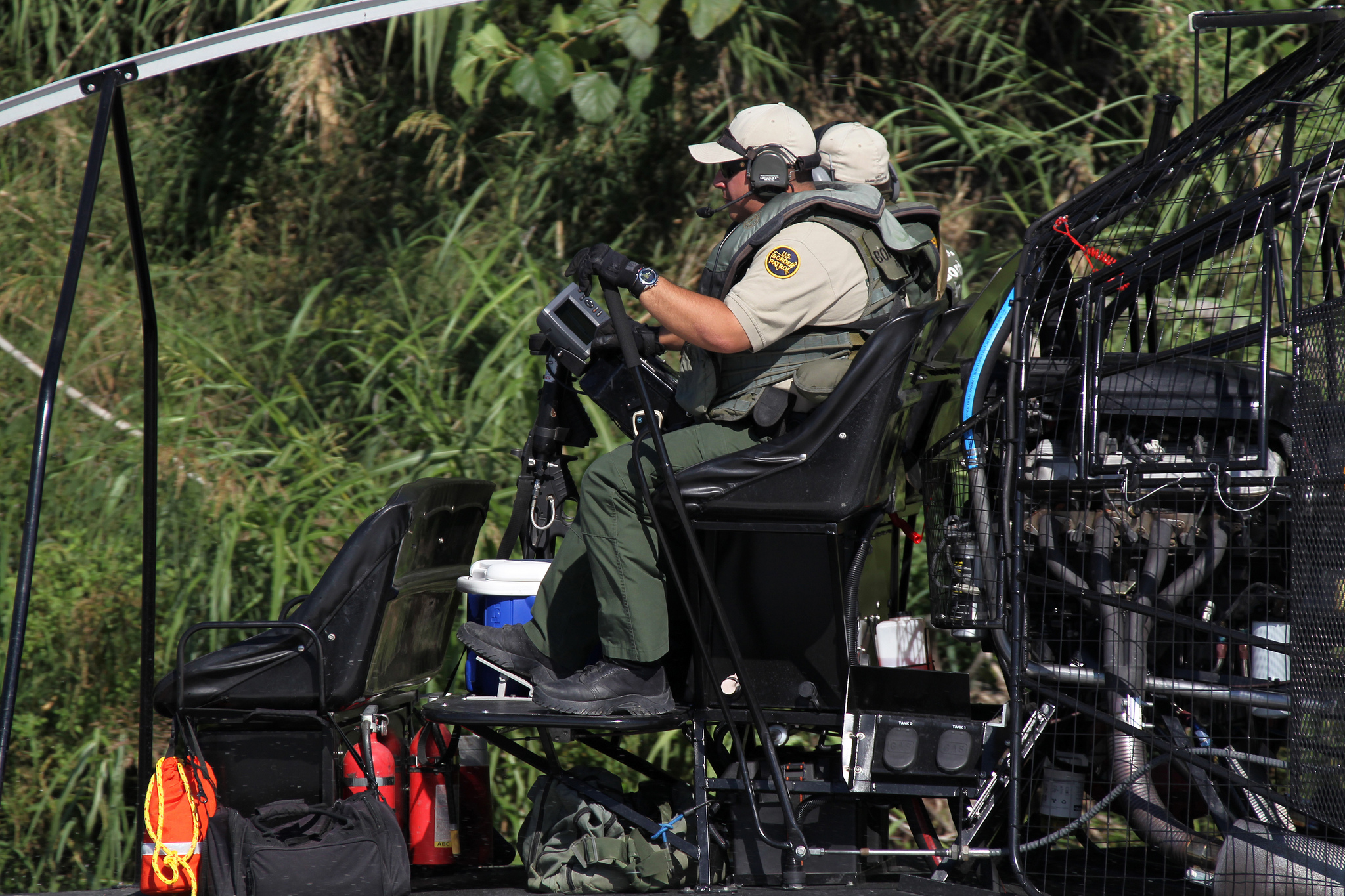
Patrolling the Rio Grande
The Southwest river border begins near Yuma, Ariz., running 1,250 miles through streams, creeks, lakes and rivers to the mouth of the Rio Grande at Brownsville, Texas. Several hundred miles of the Southwest water border is deep enough for boats, but the waters are rocky and difficult to navigate, with currents and depths that can change by the hour. Depths range from just a few inches in most places to more than 200 feet in Lake Amistad, Texas. The terrain on both sides of the water border is scrubby, isolated and largely uninhabited.
As on any other part of the long Southwest border, criminals probe for weak points on the water border to smuggle drugs and illegal immigrants. Against this threat, Customs and Border Protection has organized the riverine force, staffed by specially trained U.S. Border Patrol agents using a fleet of watercraft to patrol along the Northern and Southwestern water borders. Often working with CBP’s Office of Air and Marine and land-based agents, Border Patrol riverine adds a layer of waterborne border protection from airboats and other vessels moving as fast as 45 miles per hour.
“It’s just like any other vehicle you would drive,” Airboat Vessel Commander Rolando Cantu explained. “The only difference is that we’re in the water. If you are in a patrol truck, you have to be aware of your surroundings. On the water, you have to be aware of the weather, the water levels and the rocks. We study the river to learn as much as possible and try to avoid the hazards.”
“Riverine operations are a small portion of Border Patrol’s total force,” explained Border Patrol Agent T.J. Harris, a marine standardization evaluator at Del Rio, Texas. “But riverine operations help patrol the border in ways that were impractical or maybe not even possible before,” said Harris. “In that sense, riverine plays an extremely important role in Border Patrol’s operations.”
Patrolling coastal waters, on the other hand, is the responsibility of CBP’s Office of Air and Marine, according to Assistant Chief Jerry Galvan, Border Patrol riverine program manager. “If a body of water is so large you can’t see the other shore, it’s patrolled by OAM,” Galvan said.

Riverine operations on the Southwest border
Below the dam on Lake Amistad, the Rio Grande River becomes shallow and irregular, depending on the amount of water released from the dam. Water depths in this part of the river can quickly vary from a few inches to 3 feet. “In this part of the Rio Grande, the river changes by the hour,” Galvan explained. “It’s not unusual to go up the river one way and a few hours later to take a different return route.” Airboats are used exclusively on this part of the water border, carrying two to three agents, depending on the mission.
Above the dam, Del Rio Border Patrol Sector conducts riverine operations on Lake Amistad, a large reservoir managed jointly by the U.S. and Mexico through the International Boundary and Water Commission. Lake Amistad was created in 1969 with the construction of the Amistad Dam. The lake is a huge recreation area, drawing thousands of fishermen every year for national angling tournaments. Amistad is more than 200 feet deep in places, spanning 65,000 acres, with a U.S. shoreline of 547 miles. The original pre-dam channel of the Rio Grande River marks the border in the lake, which is patrolled by Border Patrol V-hull Safe Boats measuring from 17 to 27 feet long. Riverine operations began with used Safe Boats transferred from the U.S. Coast Guard. All Safe Boats in riverine service have been bought new in the past few years or completely refurbished.
Serving as an airboat vessel commander, Border Patrol Marine Agent Rolando Cantu of Eagle Pass North Station knows his boat makes a difference. “I believe as soon as we turn that boat on it deters anyone who is thinking about crossing the river in that area,” Cantu explained. “We’ve had situations and incidents where people are trying to cross the river and as soon as they hear the boat coming, they turn right around and go back to the Mexican side. The boat is pretty loud. I can’t give you an exact number on the decibels, but it’s loud.”
At the helm of a Safe Boat, Border Patrol Marine Agent Ricardo Gonzales serves as vessel commander. “Compared to airboats, we are seen, but maybe not heard as far away as an airboat. Our presence serves as a deterrent,” said Gonzales. “Also, we’re out there as public servants. Whenever there is someone who needs help, somebody out there on the water who gets stranded, we are there to help.”
Gonzales also explained his relationship with his crew members. “We share responsibilities from the very beginning, trailering the boat every day,” he said. “The crew knows their responsibilities, I know mine, but ultimately if something goes wrong, most of the responsibility is going to fall on my shoulders.”

Riverine agents require specialized training
“Being on riverine isn’t just a Border Patrol agent who decides to ride around on a boat. There is a lot of training and preparation, starting with a supervisor interview,” explained Gary Tharpe, deputy director of riverine training at OAM’s National Marine Training Center in St. Augustine, Fla. “Not all volunteers find their way to an actual assignment on a vessel. New riverine agents must pass a 24-hour course leading to certification as a crewman. From that point, crewmen are evaluated for fitness for riverine duty.”
If approved, they attend the four-week Marine Law Enforcement Training Program, taught at the Federal Law Enforcement Training Center in Glynco, Ga. According to Tharpe, the course “covers many subjects, from diagnosing a dead boat motor, to handling fuel, to firing a weapon from a moving boat.”
Graduates return to their duty stations and report to vessel commanders at 39 Border Patrol riverine locations – 23 located along the Northern border, and 16 on the Southwest border. Galvan explained that most riverine patrol activity in the Southwest occurs in the Del Rio, Laredo and Rio Grande Valley Sectors. “Del Rio Sector uses Safe Boats on Lake Amistad. The other sectors, downriver, are very shallow and can only use airboats,” Galvan said. Safe Boats are highly stable watercraft.
Riverine duty challenges and rewards
Border Patrol Agent Abraham Cardenas has served on Safe Boats for more than six years as a crewman on Lake Amistad. Describing the operating challenges on the lake, Cardenas explained, “the water level changes a lot. You can have obstructions that pop up here and there. Safely navigating is challenging due to the constantly changing depths.”
“But our training is topnotch,” Cardenas continued. “We’re always trying to raise the bar. I also like the opportunities we have to operate in challenging weather conditions. And compared to air boats, we have a cabin we can duck into during bad weather.”
For agents considering a switch to riverine, Cardenas reflected, “the riverine program isn’t for everyone. You really have to enjoy getting on that boat every day and doing your job. As a crewman, you also need to be comfortable and confident around the water, and remember the need to be safe.”

New riverine vessel in development
In addition to airboats and Safe Boats, a third type of vessel will eventually join the riverine fleet: the riverine shallow draft vessel. This boat uses a water jet propulsion system, avoiding the use of a propeller that can easily break in the shallow and rocky waters on the southwest border. Like an airboat, the shallow draft vessel can operate in 4 inches of water, but offers greater stability and crew safety. The new vessels will also be fitted with a small protected area to shelter crews from the weather.
The new boat is still in development, and has been tested in the Laredo and Del Rio sectors. Galvan expects CBP to eventually purchase 30 or more of the new vessels.
Like other Border Patrol vessels, the shallow draft vessel’s operational requirements were developed by the Border Patrol, but the vessels will be owned by OAM. “OAM owns the riverine domain, fuel funding, training and program standards,” explained Galvan. “All of the boats are on OAM’s books – and Border Patrol provides the agents and manpower to execute the riverine mission.”
Advanced Riverine Training – National Marine Training Center
All riverine training courses that advance beyond crewman are taught at OAM’s National Marine Training Center in St. Augustine, Fla. The center has six full-time instructors in the riverine program.
“We train about 150 Border Patrol agents every year in the riverine program,” said Center Director Martin Wade said. “In addition to training all vessel commanders, we also train marine instructors and marine standardization evaluators for Border Patrol riverine.” Standardization evaluators ensure that field training in the sectors meets standards for uniformity and competence across the riverine force. CBP sends an average of 550 students a year to St. Augustine to train for coastal marine interdiction and riverine programs.
Approximately 90 percent of students graduate from the challenging training courses. “There is a perception that a lot of people have that, ‘Hey, I have my own boat, it doesn’t take much to operate it, and anybody can do it,’” Wade explained. “We’re not asking people to operate these boats in a recreational capacity, we’re training them to operate a boat in a marine law enforcement capacity. It’s entirely different, and we put a lot of rigor into the training and certification processes.”


